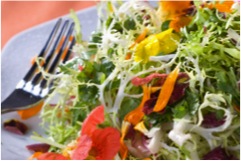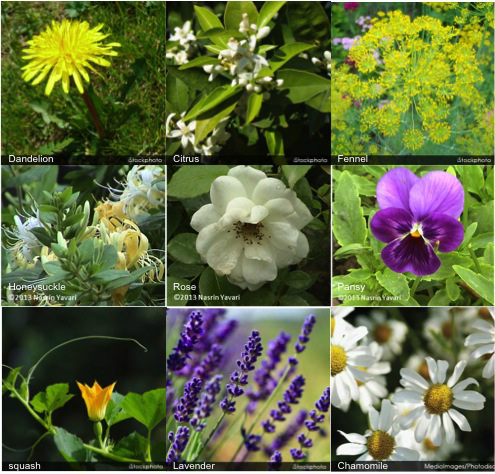|
Flowers of many plants are being used since antiquity in traditional cooking, to bring flavor, taste and color into the food preparations. They include vegetable flowers, herbal flowers, fruit flowers and ornamental flowers known for their culinary or medicinal properties. Today eating fresh flowers are becoming popular much as a garnish but also as an integral part of a dish. Squash flowers can be fried or stuffed, other edible flowers like Rose and Pansy are candied; many more are served frozen in ice cubes; made into jellies and jams; used in teas and other beverages; added to cheese spreads, herbal butters; and among ingredients for baking, syrup, flower-scented sugars and new salad dressings. Nonetheless some flowers are toxic, others may be edible only after appropriate preparations. CAUTION: • Remember that not every flower is edible. • Never harvest flowers growing by the roadside. • Do not eat flowers from florists, nurseries, or garden centers, they might contain pesticides. • Identify the flower exactly and eat only edible flowers and edible parts of those flowers. • Flowers served with food at a restaurant might not be edible. • Never use non-edible flowers for garnish on plates or for decoration. • Prepare correctly your fresh edible flowers. How to prepare flowers: 1- Shake well each flower to dislodge insects hidden in the petal folds. 2- Separate the flower petals from the rest of the flower and keep the edible part just prior to use. 2- Wash the flowers by putting them in a strainer placed in a large bowl of water. 3- Drain and allow to dry on absorbent paper. 4- Do not expose to direct sunlight. http://whatscookingamerica.net/EdibleFlowers/EdibleFlowersMain.htm http://www.ces.ncsu.edu/hil/hil-8513.html http://www.culinaryblossoms.com/m_1.asp http://www.treehugger.com/green-food/fresh-flowers-in-food-taste-blooming-delicious.html Common edible flowers
•Artichoke (Cynara scolymus, flower bud) Broccoli and Cauliflower (Brassica oleracea, flower buds) •Caper (Capparis spinosa, flower buds) Chamomile (Chamaemelum noblis, flowers for tea in moderation) •Chives (Allium tuberosum, lowers or buds) •Chrysanthemum* (Chrysanthemum coronarium, petals) •Citrus blossoms (lemon, orange, lime, grapefruit) •Clover (Trifolium spp, flowerheads, soaked before or boiled) Daisies (Bellis perennis, quills) •Dandelions* (Taraxacum officinale, leaves, roots, petals, buds) •Daylilies (Hemerocallis buds, flowers, petals) Elderflower (Sambucus spp, blossoms for drink) •Hibiscus (Hibiscus rosa-sinensis, edible garnish) Honeysuckle (Lonicera japonica, petals ) •Jasmine (Jasminum officinale, is only edible species and for tea) •Lilac (Syringa vulgaris in salads) Nasturtium (Tropaeolum majus blossoms and seeds) •Pansies (Viola x Wittrockiana flowers, petals) •Pot Marigold- Signet (Calendula officinalis, petals with white heel removed) •Roses (Rosa, petals with white heel removed, rose hips) •Sunflowers* (Helianthus annuus, petals, seeds) •Violet (Viola tricolor leaf and flowers in salads, candied flowers for pastry decoration, small amounts) •Zucchini blossoms (Curcubita pepo blossoms) * Only the petals are edible, pollen is highly allergenic Flowers to decorate a dessert - Apple blossom, clover, mint flowers, pansies, rose buds and petals, violets. Flowers you can eat whole -Alliums (leeks, chives, garlic, garlic chives), Basil, Clover, Dill, Fennel, Honeysuckle, Johnny-Jump-Up (Viola tricolor), Lavender, Mint, Rosemary, Runner bean, Sage, Savory, Thyme. For recommended plants with edible flowers: http://www.ext.colostate.edu/pubs/garden/07237.html For vitamins in flowers: http://articles.mercola.com/sites/articles/archive/2012/04/18/42-edible-flowers.aspx For a list of researched edible flowers: http://www.thompson-morgan.com/edible-flowers |
|
Archives
July 2020
Categories
All
|


 RSS Feed
RSS Feed
